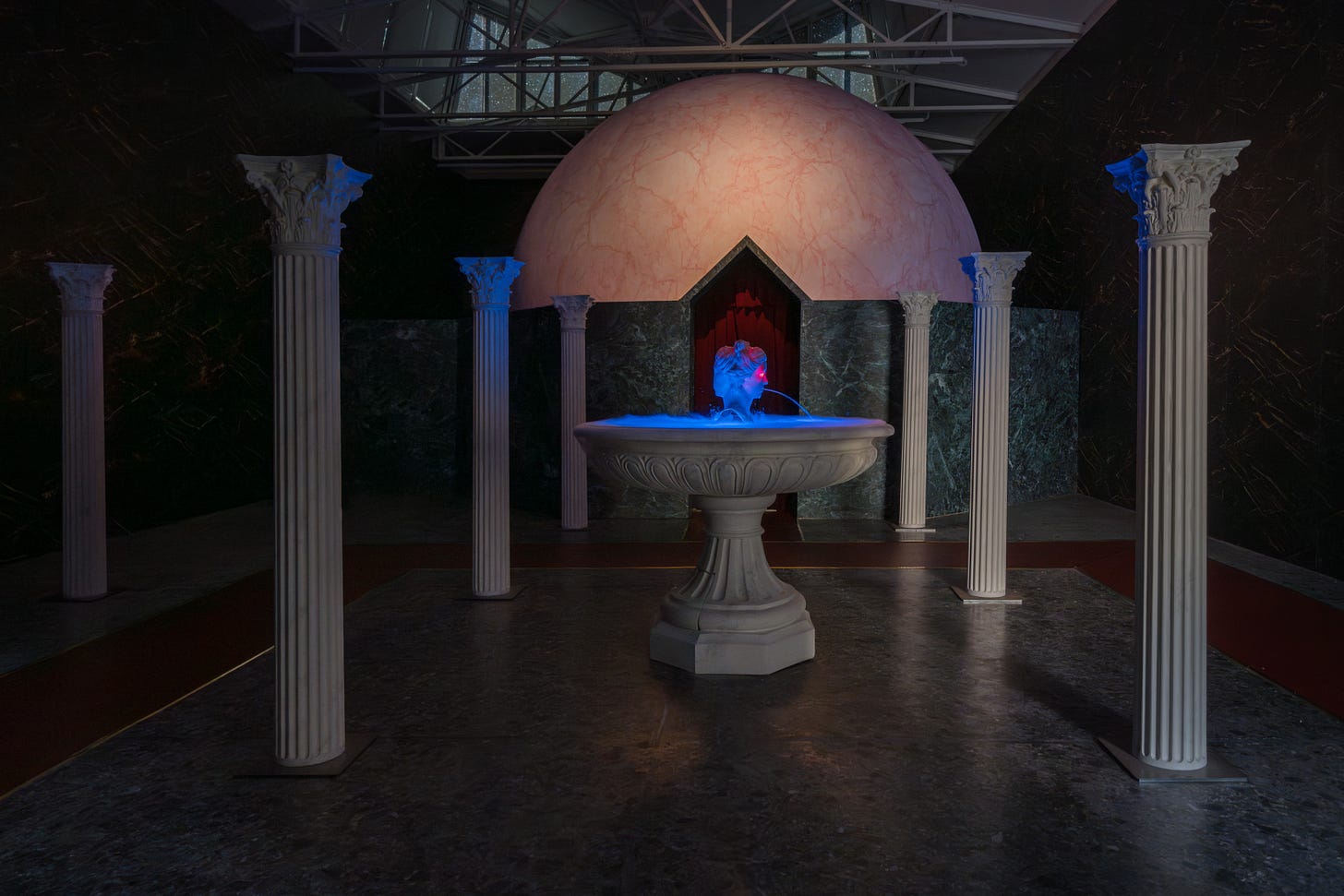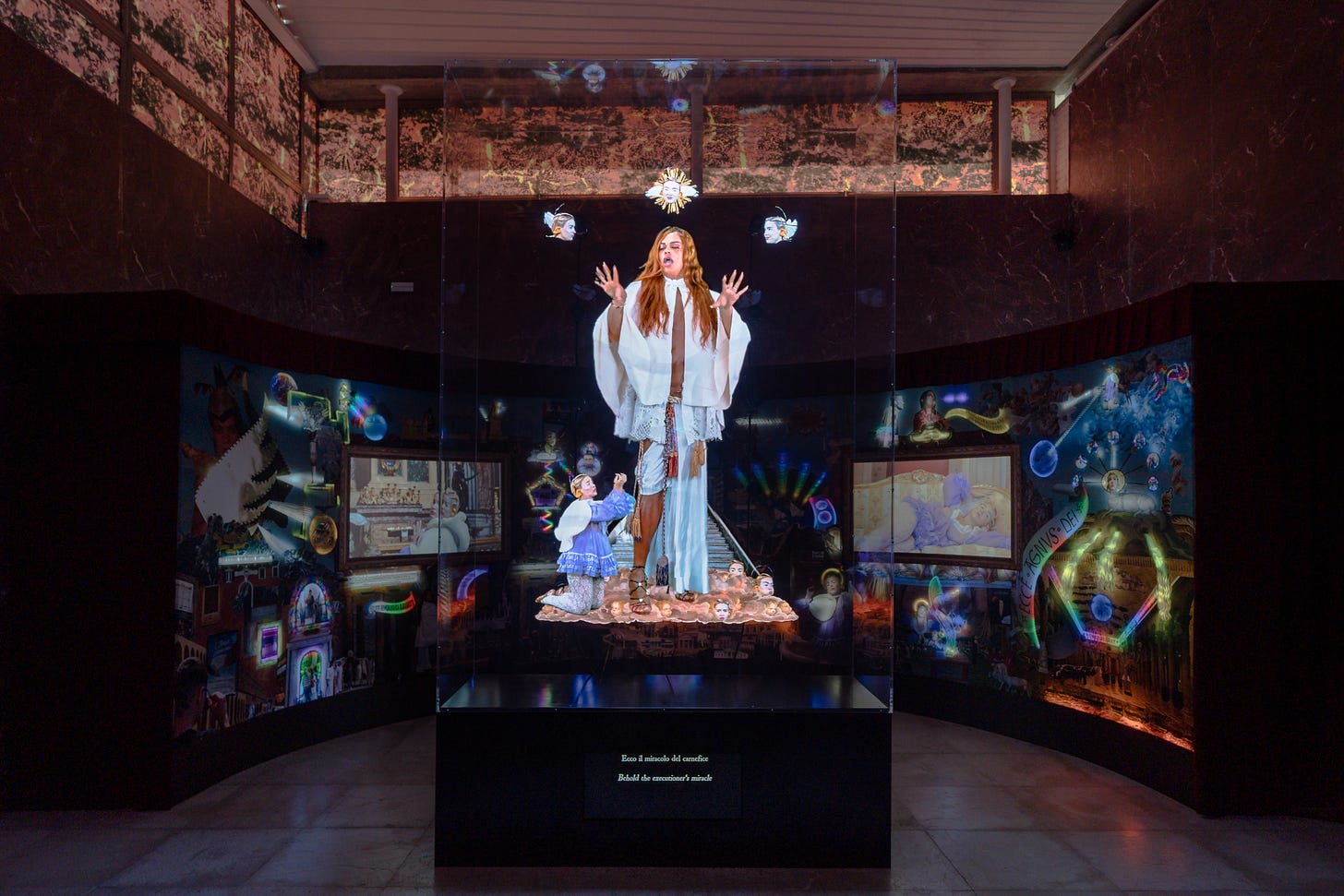The Venice Biennale 2024: The Giardini Pavilions (Part 2)
This week, we continue with the Giardini, looking into a controversial accusation, the colonial entanglement of a giraffe, and the self-fashioning of a proud nation.
Netherlands: The International Celebration of Blasphemy and the Sacred
The Congolese collective Cercle d’Art des Travailleurs de Plantation Congolaise (CATPC) brings forth accusations against the white cube museum: It’s sustained by the human and material resources extracted from Congo and other countries from the Global South. Companies that have historically made a fortune off cocoa, palm oil, and the disposession of farmers get to play philantropists, generously founding and mainting astonishing museums around the world. The world being the West / the Global North, of course.
The pavilion is dripping with palm oil running down its facade. Inside, chocolate copies of wooden figurines are displayed. CATP uses the profits made off the wooden originals to buy back and reforestrate plantation land in Congo. It’s rare to see such an intertwined example of activism and art.

Three films take turns on a screen that, turning dark, throws back the reflection of the people sitting in front of it. I feel called out sitting here. The three films follow the accusation of the white cube in a metaphorical courtroom taking place outside. Western arguments defend the white cube, bringing unity, boosting the economy, safely storing the objects that would be destroyed if brought back. The accusers bring forth the evidence of exploitation, pointing out the resources that museums around the world were financed with. The verdict is clear: The white cube must return all land and the ancestral figure Balot.
Balot is a wooden sculpture portraying the white colonial administrator Maximilien Balot, made in 1930s Belgian Congo. How odd to see the likeness of an oppressor being welcomed back, its return celebrated by the people. The figure is exhibited parallely to the Biennale in the White Cube museum in Lusanga.
The film doesn’t explicity mention that the sculpture is returned merely temporarily, “on loan” from the Virginia Museum of Fine Arts. The film only alludes to the fact when, in the final frame, the collective returns Balot into a box.

National Pavilion of the Netherlands, Giardini, La Biennale di Venezia
Czech Republic: THE HEART OF A GIRAFFE IN CAPTIVITY IS TWELVE KILOS LIGHTER
The Czech participation is exciting in two ways this year. Not only does it mark its comeback after its closure in summer 2019 (a tree looked at the roof and said don’t mind me if I do…), it also goes straight into decolonization.
Czech society has fallen into amnesia regarding its complicity in colonialism, but Eva Koťátková (Millenial, Czech) has the receipts. The exhibition follows the life and death of Lenka, the first giraffe in Czechoslovakia, brought to Prague Zoo 70 years ago. Hunters captured Lenka in Kenya, then still part of the British Empire, thanks to cheap hunting permits. After a tiresome journey through several countries, poor babygirl survived only two years in the zoo before dying of pneumonia. Lenka’s body was donated to the National Museum where it was exhibited until 2000. Yet her story continues.

Eva took it upon herself to keep Lenka’s story alive: A huge giraffe neck expands in the pavilion. Its insides are exposed just like Lenka’s after her taxidermy. Visitors can walk through her body and listen to stories about her.
The sewage in the center of the hall is exposed, a speaker box inside plays the heartbeat of a giraffe, poetry and the National Hymns of those countries that Lenka visited on her way to Prague. The exposed pipes here and there allude to the myth of Lenka’s organs being discarded in the public sewage system after taxidermy. Allegedly, half the square infront of the museum had to be closed that day due to the atrocious smell.
Eva’s presentation is an exercise in empathy, but I’m left with some doubts. Is it engaging? Hell yeah. Is it educational? It sure is. Is it art, though? With all the explanations, texts and details of the pavilion, I feel like it would be an amazing educational section for a natural history museum or a workshop space in a zoo. But in between it all, I can’t help but wonder: where is the art?

National Pavilion of the Czech Republic, Giardini, 60th International Art Exhibition, La Biennale di Venezia
Switzerland: Super Superior Civilizations
Is there a word for brainwashing that does the opposite of brainwashing? That’s what oddly describes the Swiss Pavilion this year.
The exhibition is beautifully insane and unhinged. Guerreiro do Divino Amor (Millenial, Swiss-Brazilian) executes a plot twist I couldn’t have imagined in my wildest dreams. From the outside, nothing really prepared me for what awaited me inside the halls. Some walls imitate noble dark marble surfaces like those in a monumental church or ancient temple.
Entering, I found myself surrounded by corinthian columns centering a fluorescent blue fountain with a rotating female bust. It’s Helvetia, the personification of Switzerland, and our girl is two-faced: One face has lasering red eyes, surveilling and monitoring everything within her reach, the other is crushed, blind to her surroundings. The fountain is positioned in front of a peachy and green marble observatory. Now that I think about it, it’s giving ‘80s movie set or kitsch mansion interior. From personal experience, I know my rich Russian people ate that peachy marble up back in the days. Speaking of rich people…

Switzerland is heaven on earth for the rich and wealthy. A tax haven of offshore accounts and discrete financial insitutes. A perfect system of democracy, social welfare, and meritocracy. Guerreiro doesn’t catch a break and puts a finger on all the tiny little issues nobody likes talking about: Tax evasion, xenophobia, nationalism,… Inside the observatory, I am mercilessly pulled into the immersive video like a moth to a lightbulb, drooling over the adobe photoshop level edits of one stereotype after the other: the Alps, Swiss cheese, politicians appealing to the patriotism of expats (that irony), travel infomercial slogans layered with sharp sarcasm and allusions to the crumbling façade of a nation. Switzerland: The Olymp of mortals.
Exiting the observatory and following a corridor, I find myself confronted by a musical hologram performance by Ventura Profana (Millenial, Brazilian). Ventura is taking on the role of the mythical she-wolf that raised Romulus and Remus, the founders of ancient Rome. Her deep, saturated voice made for opera and church chants stands in a fascinating opposition to the casino/playhall background drawing a love triangle between ancient Rome and Modern day Italy & Brazil. Who would have thought that Nova Pádua, the most Italian city in Brazil, is the most Bolsonarist one as well? A social media comment calls Italy God’s gift to the world. Guerreiro overlays the comment with a historical map of the American continent. I doubt the indiginous tribes meeting Cristoforo Colombo would agree…
The courtyard exposes what is always inevitably left: Rubbles of a once mighty civilization. The dead tree has turned into a pedestal for the proudly standing she-wolf.

National Pavilion of Switzerland, Giardini, La Biennale di Venezia
For more reviews and insights into the Venice Biennale, subscribe to the weekly newsletter!
La Biennale di Venezia
Arsenale/Giardini
Website
Instagram: @labiennale
Thank you for reading this review! I’d appreciate your support a lot if you’d like to like, comment or share with a friend.
See you soon!!!
Jennifer
The Gen Z Art Critic




